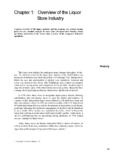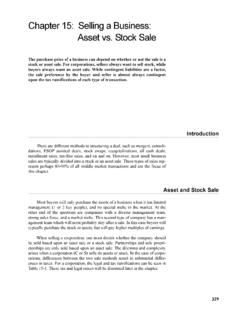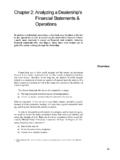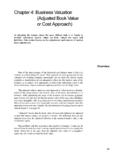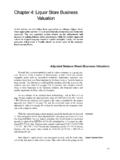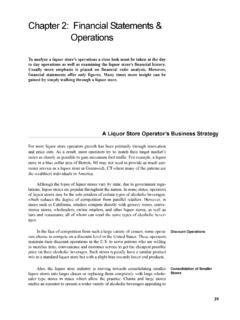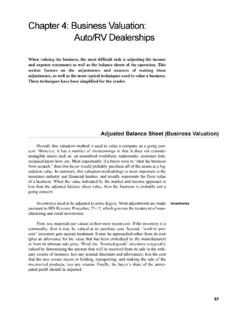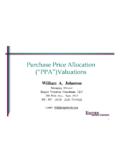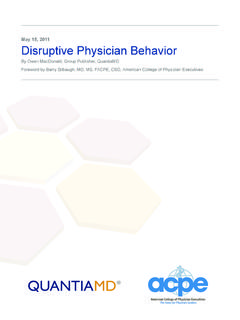Transcription of Chapter 7: Asset Valuation (Intangible Assets)
1 133 Chapter 7: Asset Valuation (Intangible Assets) intangible assets are the most difficult items to quantify and , most business sellers want a large payout for blue sky (goodwill). Quantifying intangible assets is critical for a purchase priceallocation or when selling or buying a business. Although difficult to value,this class of Asset is becoming more of an issue in today s technology drivenmarket. In some instances the intangible assets will account for themajority of the value of a vs. Intangible AssetsBoth tangible and intangible assets represent an opportunity for future eco-nomic benefits. Tangible assets are generally defined as those physical assetswhich are used for the purpose of producing and distributing goods, and some-times services. Tangible assets are usually fixed and have a physical existence(real estate, equipment, cash, accounts receivable).
2 Many times the value of aspecific tangible Asset will be measured by its assets typically have a recognizable description, have the abilityof being destroyed or terminated, and derive most of their value from expectedfuture benefits. These assets have no physical existence (for the most part). intangible assets can be measured by consideration of their costs but are gener-ally valued based on the expected economic income to be generated by the assetover a period of businesses with a low percentage of tangible assets (such as ser-vice companies and professional practices) have a large percentage of intangi-ble net worth. On the opposite side of the spectrum are Asset intensivebusinesses whose value is principally from its fixed and current assets, and lessso from intangible assets . Figure 7-1 on page 134 can more accurately showthese differences for various types of that two companies have identical cash flows: (a) Company Ahas 20% of its value in intangible assets , with 80% in tangible assets; and, (b)Company B has 80% of its value in intangible assets , with 20% in tangibleassets.
3 Company A will probably have more debt, need more of a reserve for thereplacement of short lived assets, and is possibly a high commodity business,relative to Company B. These differences are important to understand when val-uing a business or the intangible Asset Valuation (Intangible Assets) 134 Figure 7-1: Differences in Fixed versus intangible assets for Various BusinessesReasons for Valuation of Intangible assetsTable 7-1 lists the most typical reasons for the request of an intangible 7-1: Reasons for Intangible Asset ValuationsCategoryReasonPurchase Price AllocationStatements of Financial Accounting Standards(SFAS) 141 & 142, IRC 1060, IRC 197 Pre-acquisition AssessmentDiscerning what is tangible vs. intangiblePurchase of Selected AssetsLicensing or purchaseFinancing PurposesFinancingBankruptcySolvency, Collateral, taxation issuesRoyalty Rate NegotiationNegotiationsIntercompany Transfer PricingIRC 482 Tax PlanningEvaluating gains/lossesAd Valorem TaxesTax reduction LitigationDamagesAsset Valuation (Intangible Assets) 135Of the intangibles shown in Table 7-1, Section 197 assets are the mostcommonly valued intangibles .
4 Section 197 intangible assets are assets catego-rized by the Internal Revenue Service for amortization over 15 years. Section197 assets include:(1)goodwill and going concern value, and covenants not to compete as they relate to the sale of a business;(2)workforce in place;(3)information base;(4)know how;(5)any franchise, trademark, or trade name;(6)any permit, license, or other right granted by a government agency;(7)any customer based intangible;(8)any supplier based IntangiblesTable 7-2 shows a general list of intangibles which are usually encounteredin a business. Note that assets which are not easily identifiable are usuallyreferred to as goodwill. Both identifiable and unidentifiable intangibles may have unlimited usefullives. Depending upon the type of Asset , the useful life may be limited to factorssuch as legal, contractual, or regulatory provisions, competition, life expectan-cies of employees, and economic 7-2.
5 General List of intangible assets *FormulasLoan and Mortgage PortfolioFiles and RecordsKnow HowCopyrightsFilm and Record LibrariesPersonnelCore Bank DepositorsFilm RightsTrademarks and NamesCovenants Not To CompeteFranchise AgreementsPackagingCustomer Lists & GoodwillUnpatented TechnologyIndirect Construction CostsDesigns, Drawings, and ModelsBacklogRun-In CostsDistribution NetworksContractsSystemsEasement RightsLeasehold InterestsMicroficheFavorable DebtsLicense AgreementRightsMineral Water RightsLocation ValueGoing ConcernPatentsSoftwareAssembled PlantPatent ApplicationsTrade SecretsWo r k F o r c ePerformance RightsProduct Line* this is not a comprehensive listAsset Valuation (Intangible Assets) 136 Valuations are mostly requested for: patents trademarks and names covenants not to compete goodwill copyrights and trade secretsMost intangible assets are valued based upon a cost, or an income , most values rely upon proforma (future) projections.
6 A discus-sion of the different approaches to valuing intangibles is presented first, fol-lowed by an overview of these four most requested ApproachThe cost approach is the total of all expenses incurred to create the intangi-ble Asset . Two important components of the cost approach are useful life andobsolescence. The most common techniques of establishing the useful life are: The remaining legal life ( , for a patent, trademark, license, copyright or contract) Remaining physical life Remaining functional life (certain chemical formulas, in say lubricants or cleaners, become obsolete if they are not continually updated) Remaining technological life ( with computers, 486 technology gives way to pentium technology, and so forth) Economic Life Actuarial Life ( cable subscribers, or telephone advertising customers)ObsolescenceObsolescence (when something has a diminished value versus its originalcost) is an important concept.
7 While it is usually discussed in a cost approach, itis most pertinent to an income approach. Obsolescence of a product, a trade-name, or mark related to the product, depends upon the industry in which thecompany operates, and whether goodwill is typical in the industry. In someindustries, obsolescence can occur within 3-6 months ( , computers/soft-ware), while in other industries, obsolescence can occur after decades or 7-3 shows the differences in various industry products with respect why does obsolescence matter? Well, one should not capitalize anincome stream or attribute a value to an intangible Asset which is continuallylosing value. This problem can be circumvented by making the discount rate afunction of the rate of obsolescence [ 20% discount rate - (-25% growth rate)= 45% discount rate].
8 The 25% would represent an erosion of 25% of the exist-ing Valuation (Intangible Assets) 137 Another method which can be used is to utilize a capitalization or discountrate which incorporates a steady erosion of earnings for a finite period of concept is similar to a sinking fund (1) of Sinking Fund and ObsolescenceLet s assume that a product has a life expectancy of 4 years, and at the endof the 4 years the product will be obsolete (have no value). Assuming thattoday s safe rate is , a speculative rate of 30% over and above the safe rate,and today s net income from the intangible Asset is $175,000, then the value ofthe Asset would be calculated in Table 7-4 to be $330, (2) of Sinking Fund and ObsolescenceSimilarly, let s assume that the discount rate for an intangible Asset is 35%,assuming no growth or erosion of income and assuming in the previous example(Table 7-4) that the value of the Asset will lose 75% of its value in 4 s present value can be calculated below:(EQ 7-1)Table 7-3: Economic Obsolescence of Different Industry ProductsIndustryAge LifeComputer Hardware1-36 monthsComputer Software1-36 monthsChemicals1-10 yearsPharmaceuticals1-15 yearsSteel1-20 yearsPlastics1-15 years1.
9 A fund in which periodic deposits of equal amounts of money are accumulated to pay a debt or replace 7-4: Sinking Fund Calculation for Obsolete Intangible AssetVariableCalculationSinking fund factor for 4 years @ : speculative rate30%Total capitalization l u +()41 $175 000, $330,064=Present Value$175, () ()41 ()------------------------------- ---------------------------------------- --------------------------------=Present Value$175, Valuation (Intangible Assets) 138 Patent Cost ItemizationThree examples of the use of the cost approach can be seen below. The firstexample is simply a patent cost itemization for a pharmaceutical drug, whichcan be seen in Table 7-5. Trained Work ForceSecond, the existence of an assembled work force provides a potentialbuyer with an Asset that saves him from having to hire workers, train them, andmake them productive.
10 If a trained work force were not assembled, then a pur-chaser would have to incur these costs in developing these replacement valuing a trained work force, consideration is given to costs andexpenses that would be incurred to assemble that group of employees. Thesecosts may include the following: costs for advertising and searching for employ-ees, screening and interviewing, relocation expenses, administrative, and orien-tation and training. Assuming that a company has an average number of 46 employees, andthere is a typical loss of 5% per year, the average salary is $41,000, and theaverage cost to recruit a new employee takes 5% of the base salary for recruit-Present Value$377 910,=Table 7-5: Cost Itemizations for a Drug PatentItem20X120X2 TotalResearch & Development$1,820,000$5,200,000$7,020,00 0 Research Salaries$5,800,000$6,400,000$12,200,000 Legal Fees$2,010,000$2,910,000$4,920,000 Total$9,630,000$14,510,000$24,140,000 Table 7-6.
